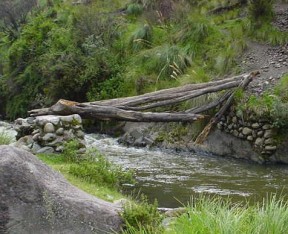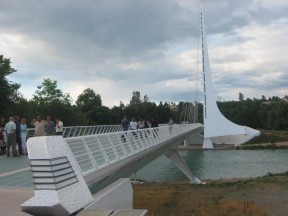Bridges are spaces. Bridges are places, where people meet other people, enjoy their surroundings, and experience being part of a community. Though a mode of transit, bridges can be magnets for public activity and fun. Bridges not only connect land to land, but also have an impact on adjacent parks, industries and residential communities, and interact with the city’s transportation infrastructure. Andrea Palladio, the great 16th century Italian architect and engineer, hit on the essence of bridge building when he said “…bridges should befit the spirit of the community by exhibiting commodiousness, firmness, and delight.”
Bridges have played an important role in the history of human settlement. The first bridges were natural, such as the huge rock arch that spans the Ardèche in France, or Natural Bridge in Virginia (USA). The first man-made bridges were tree trunks laid across streams in girder fashion, flat stones, such as the clapper bridges of Dartmoor in Devon (UK), or festoons of vegetation, twisted or braided and hung in suspension found in India, Africa and South America. As the time passed, horses became plentiful; wagons and carriages were available; roads were built. Then it was that the rivers became barriers to transportation. Ferries were established and did very well for a while, but eventually it became evident that bridges must be built.
Man has come a long way from tree trunk bridges.
While artists and engineers, cities and countries compete to build technological masterpieces spanning across rivers, oceans or connecting cities and countries; people come up with innovative ways of using them. Though designed and built by the Department of Transportation, bridges are a peoples’ domain.
Sun Dial Bridge: Soaring to touch the clouds
Spanning north- south across the Sacramento River in Redding California, the Sundial Bridge sits as a very lyrical creation with its lone pylon on one bank soaring at an acute angle to cast a shadow that indicates the time of the day.
Its setting in an ecological preserve, as well as its mystified form enhances its presence in the luxuriant landscape of Redding. Residents and tourists enjoy its ethereal sculptural quality rising from its ‘all-white’ softness of exaggerated parabolic curves against the floating clouds and the infinite horizons.
The drama does not end at its translucent green glass 700 foot deck pulled by 14 galvanized steel cables. It converges at the bottom of the bridge where it has nestled a small amphitheatre enveloped by concrete walls clad with broken white tiles. The profile directs upwards and frames one of the most magical and unexpected views. You will gasp in astonishment as you view the 105 foot wide base converge to a 5 foot tip and vanish into infinity, through the hollow glowing as a halo. It is at this junction that the whole structure lends itself as a mere transparent membrane between the viewer and the infinity. And it is here that the structure sheds its physical attributes to soar into the serenity of nature as a ‘bridge’ between the real and celestial, and let the viewer experience the tranquil sky from the womb of the earth.
Its architect Santiago Calatrava had remarked, ‘the bridge has its essence and the essence is an opportunity to do something ecologically and environmentally pristine inspite of its variants’. Sundial bridge is not just a pedestrian bridge; it has become a people’s place, a place where people gather and enjoy the architectural creation and nature in unison. They enjoy the space.
Pics by Vani Bahl
Vani Bahl is a building designer (USA), and a licensed architect (India). She has keen interest and expertise in two fields- green building, and restoration of buildings for adaptive reuse, which she feels are not mutually exclusive. Nature of her works includes residential, light commercial interiors, hotel design and planning, and campus planning. Her projects are in USA, and her native India. Vani has contributed as researcher towards two books- Dome Over India by Aman Nath; and Documenting Chandigarh: The Indian Architecture of Pierre Jeanneret, Edwin Maxwell Fry, and Jane Beverly Drew by Kiran Joshi. She has also written for several architectural journals including Architecture + Design, Indian Architect and Builder, and Architecture Week.










